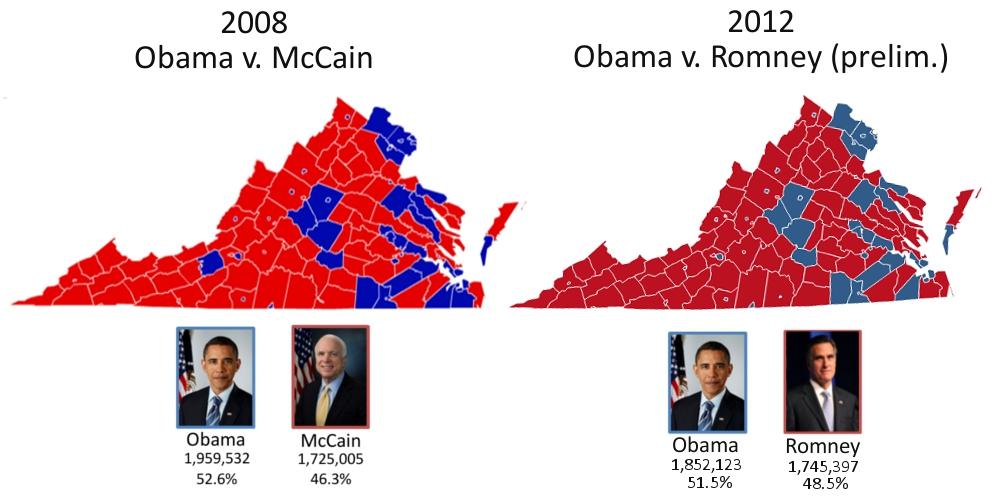Forget Ohio, it’s all about Virginia…and demographics
In my humble opinion, the biggest news coming out of the election last night was not Ohio. Instead, the polling results coming out of Virginia, that heavily favored Obama early in the evening, set the tone for the entire night. The story of what happened in Virginia exemplifies where our politics in this country now stand. Obama’s repeat victory in the Old Dominion underscores what was probably the biggest factor in the 2012 election: demographics.
For our regular readers, especially those who read our Red State, Blue State report back in July, this shouldn’t come as too much of a surprise. Ohio, Florida, and other swing states are used to the attention and have been “purple” for a long time now. Obama’s repeat victory in Virginia, however, a state that has voted consistently for Republican presidential candidates before 2008, is really big news. More than anything else, Obama’s victory in Virginia means that 2008 wasn’t a fluke, but rather represented a fundamental political realignment in the country.
That realignment is bad news for Republicans. The Republican party has serious demographic problems. Virginia’s shifting demographics, like that of the nation, have been dramatic in just the last few decades with Hispanics and Asians driving most population growth and changes in the electorate. Republicans have had considerable difficulty gaining the votes of these groups. In Virginia, most of the influx and growth in Hispanic and Asian populations is occurring around the Washington D.C. suburbs in Northern Virginia (NoVa). It was therefore not surprising that NoVa was the focus of the national news media, and results from that region look more like those from 2008 than from 2004.

In our previous post “Climbing Mount NoVa in 2012,” I stressed the importance of Loudoun and Prince William Counties in NoVa in deciding the outcome in Virginia, and this held true last night. The margins of victory for Obama in these key suburban counties almost match what he got in 2008. Four years ago, Obama won Loudoun County with 54% of the vote and Prince William with 58%. Last night, Obama won both counties with 52% and 57% of the vote, respectively.
| Obama 2008 | Obama 2012 | |||
|---|---|---|---|---|
| Obama’s share of the vote in key NoVa Counties | ||||
| Fairfax County | 61% | 59% | ||
| Arlington County | 73% | 69% | ||
| Loudoun County | 54% | 52% | ||
| Prince William County | 58% | 57% | ||
Of course the reason we care so much about NoVa is the huge number of votes in that region. Last night, votes from NoVa accounted for over 27% of all votes cast in Virginia, a similar percentage as in 2008 (actually a little smaller share than what I was expecting…but results are still coming in). The number of votes from Loudoun and Prince William Counties alone was over 315,000. Much of Obama’s victory in NoVa is due in large part to minority groups in the region.
Another big story coming out of Virginia last night was black turnout. Blacks accounted for nearly 19% of the electorate four years ago, and, if you believe CNN exit polling, blacks made up 20% of the voters in Virginia this year. This is a remarkable development in the history of politics in Virginia, a state that not too long ago exemplified the Jim Crow South and voting suppression. We will get better turnout numbers in the months to come, however anecdotal evidence and news reports do suggest that black turnout was indeed high last night.
There’s no doubt minority turnout helped Obama. According to the Virginia exit polls, Obama won 93% of black voters and 65% of Latino voters — essentially identical to his 2008 support of 92% and 65%. Asian voters gave Obama 66% of their votes, up from 61% in 2008. And while Obama’s support among white Virginia voters was only 38% in 2012, this represents no real change from 2008 (39%).
In short, Republicans will have a hard time winning a state like Virginia if it remains a party that primarily appeals to older whites. What is true in Virginia is true nationwide and in many other states that are experiencing similar demographic trends. If the Republican party does not start reaching out to these growing parts of the electorate, like Hispanics, will states like Texas become purple states? Undoubtedly we will be seeing more news coverage in the next few weeks on this dilemma within the Republican Party, and how the party establishment and the ideological purists wage this debate will be a central question for the party’s future.


